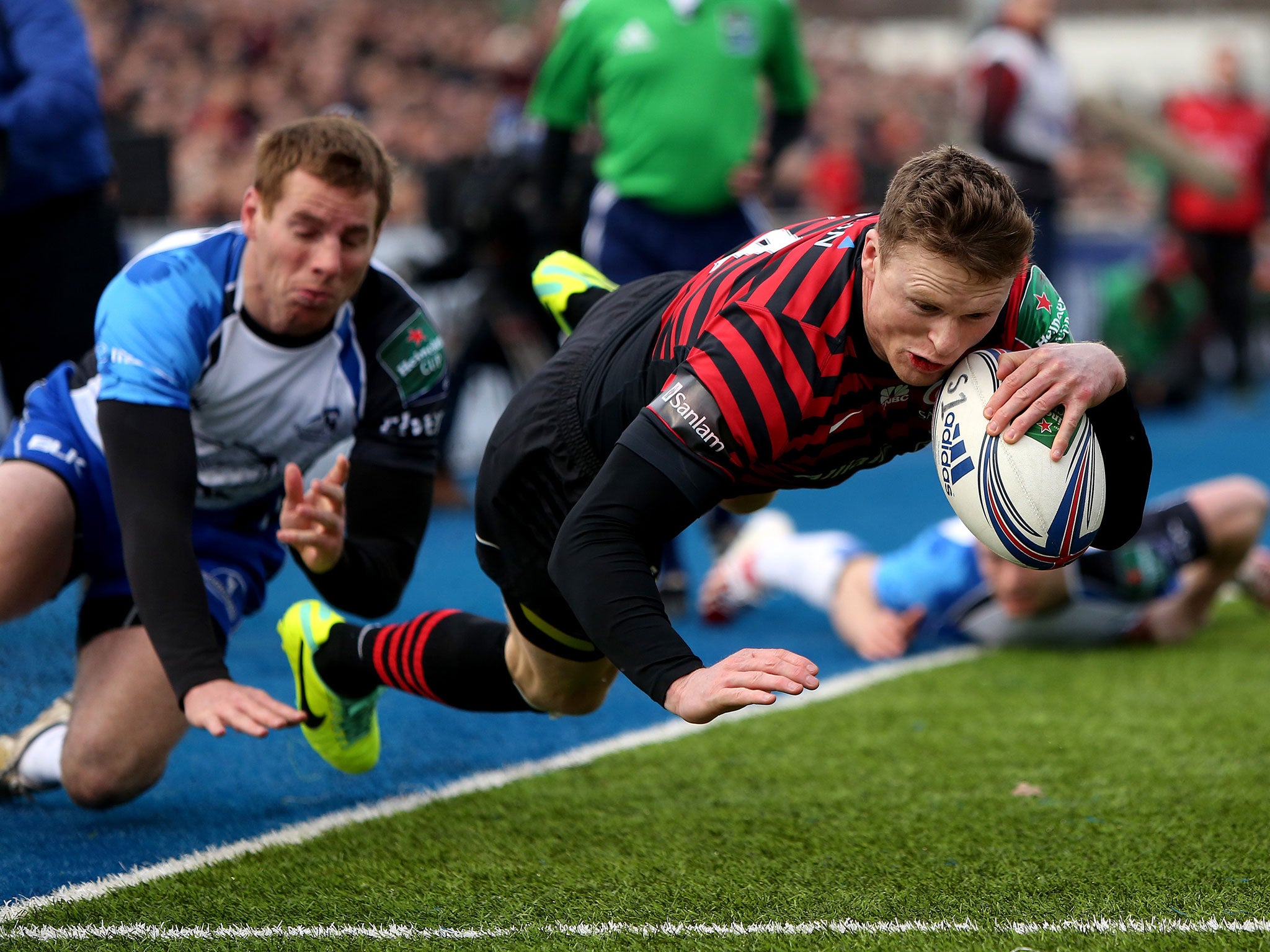Alex Goode’s added pace is bad news for Mike Brown
I’ve been working on my leg power, my pace; I feel more confident

The only thing preventing Alex Goode from being a world-beater of a full-back is the fact that his legs refuse to work as quickly as his brain, so when he leaves an entire back division for dead in taking the scenic route from the left touchline to the right corner for one of the tries of the season, there are only three possible explanations: that he has somehow found the knack of speeding up as he grows older, like a latter-day Linford Christie; that the opposing defence is rubbish; or a combination of the two.
If we are to be charitable to Connacht (a struggle, frankly, given their performance in losing 64-6 in a hopelessly one-sided Heineken Cup pool match to which the word “contest” could not be legitimately ascribed), we should at least make a case for the third of those options. Certainly, Goode believes he is running faster this season than he did last, when he was his country’s first-choice No 15, and if his opinion is supported by the computer readouts over the next week or so of Six Nations training activity, he may yet pose a serious threat to Mike Brown of Harlequins, who succeeded him in the red-rose starting line-up and finished the recent autumn internationals with England’s “man of the series” gong.
“My last injury lay-off gave me a chance to look carefully at my game, to reflect on a few things,” Goode said, a few minutes after cutting Connacht to ribbons with a series of trademark runs from deep that opened up the field for Saracens’ increasingly hostile attacking force. “I told myself that I couldn’t afford to stand still, not with people like Mike Brown breathing down my neck. So I’ve been working on my leg power, my pace, my ability to break tackles. I feel more confident as a result of it and I’m in a good position to put my best foot forward with England, although I accept Mike did a fine job in the shirt over the autumn.”
It is difficult to see Stuart Lancaster ditching Brown at this juncture: the England coach is a great one for what he calls “credit in the bank” and, unlike at least two of his predecessors in the professional era, does not consider it clever to reward good performances with bad news on the selection front. But if Goode’s performance at the weekend, albeit against opposition not so much poor as destitute, is a true measure of his form, Brown will have to play out of his skin in the early Six Nations games to hold him off.
Mathew Tait’s re-emergence at Leicester is something else Lancaster must consider as he draws together the threads of his squad for next year’s World Cup, here on home territory: assuming the great lost talent of English rugby is given a run for the second-string Saxons against the Irish Wolfhounds at Kingsholm this weekend, there will be much interest in his performance. Under the circumstances, the coach might be forgiven for wondering if he has fallen prey to the “London bus syndrome”.
Interestingly, Goode distanced himself from any return to the outside-half role for which he was bred. “I think I could do a job there, but it would be pretty unfair to judge me in a position I fill so rarely nowadays,” he said. It seems he has committed himself to life at No 15 in the belief that he still has an international future there – that if he can sharpen his pace while retaining the footballing wit and 20-20 vision of the midfield playmaker, he can establish himself once and for all as the best available choice at Test level. It will be fun watching him try.
Any fun to be had on the northern edge of the capital on Saturday evaporated once the unshackled Goode had manufactured a fine try down the left for David Strettle (who is running them in for fun these days) and then created his own minor masterpiece to leave Saracens 28-6 up with a full half-hour left on the clock. It was gruesome from there on in as Steve Borthwick’s heavyweight forwards took over, smashing the overmatched Irishmen from pillar to post with their strong-armed expertise at close quarters.
Sadly for the visitors, they may not have heard the last of it. Nathan White, their tight-head prop, was shown a yellow card for rucking the England centre Brad Barritt in a way many players of maturing years would have recognised, and there were many comments to the effect that Barritt should not have been lying there in the first place. Which is as it may be. It is, however, a fact that boots on bodies are not permitted nowadays, and that rucking close to a player’s face, as White appeared to do, has never been viewed as anything other than an outrage. Pat Lam, the great warrior hero of Samoan rugby who now coaches Connacht, described White’s action as “reckless” and will not be surprised if the authorities involve themselves in the issue.
There are those in Heineken Cup officialdom who will view Saracens’ progress to the knockout stage as an outrage in itself: the English clubs insist they will boycott the tournament next season and the Londoners have been as outspoken as any in their rebelliousness, to the point where the rugby establishment, not least in Ireland, reddens with anger at the very mention of their name. Should Goode, Borthwick and company do a job on Ulster in Belfast in the quarter-finals, their name really will be mud.
Subscribe to Independent Premium to bookmark this article
Want to bookmark your favourite articles and stories to read or reference later? Start your Independent Premium subscription today.

Join our commenting forum
Join thought-provoking conversations, follow other Independent readers and see their replies